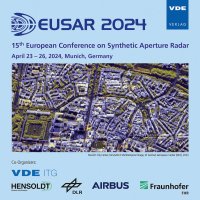First Comparative Analysis of Simulated Low and High Resolution Hydroterra and Conventional SAR Data
Conference: EUSAR 2024 - 15th European Conference on Synthetic Aperture Radar
04/23/2024 - 04/26/2024 at Munich, Germany
Proceedings: EUSAR 2024
Pages: 6Language: englishTyp: PDF
Authors:
Fischer, Jens; Scheiber, Rolf; Kubanek, Julia
Abstract:
Hydroterra was a mission proposal considered as one of three concepts for ESA’s Earth Explorer 10 mission. Its concept is to place a Synthetic Aperture Radar (SAR) into a geosynchronous orbit to measure key processes of the diurnal water cycle over regions in Europe and Africa. The azimuth integration time is thereby substantially longer compared to conventional SAR systems and it is important to know to what extent this influences the retrieval of (i) snow water equivalent (SWE) and (ii) surface soil moisture (SSM) estimates extracted from these data. To study these effects, the DLR Microwaves and Radar Institute conducted airborne SAR campaigns, 2019 at Kaufbeuren (Germany), 2021 at Wörgetal (Austria) and 2022 at Foggia (Italy). In this paper, we compare simulated Hydroterra (long integration) and conventional (short integration) SAR data acquired at Foggia. We analyze (i) image amplitude, (ii) image contrast and (iii) interferogram (coherency and phase) degradations due to temporal decorrelation on different vegetation periods (April and June) in low (Hydroterra specification) and in high (airborne SAR) resolution data, respectively.


